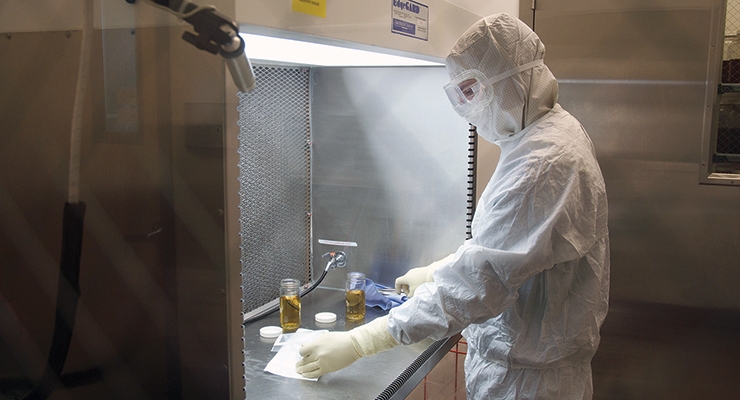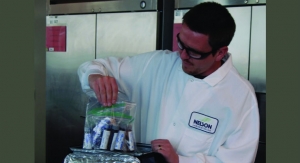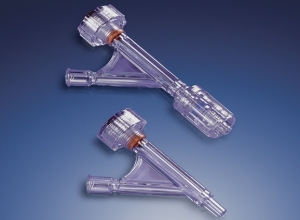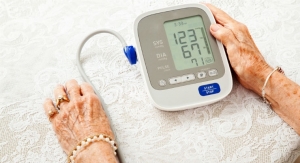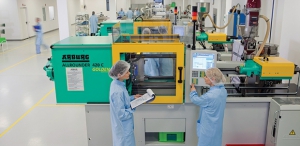Dan Floyd and Paul Littley , Nelson Laboratories Inc.04.06.16
The first question that comes to mind after completing an ethylene oxide (EO) sterilization qualification is, “When do I need to perform a requalification study, and what will that entail?” The following is a comprehensive look at the typical validation approach, the factors that determine when requalification is necessary, and how the expectations in ANSI/AAMI/ISO 11135 have changed in recent years regarding requalification.
Before looking at the requalification process, it is important to understand what is required to validate a sterilization process in the first place. Obviously, the goal is to develop and validate a repeatable sterilization process that consistently yields a sterility assurance level (SAL) of 10-6. Sterility can never be proven as an absolute; there is always a finite chance of a survivor in a sterilization process. Therefore, sterility is looked at in terms of probability. What is the probability of a non-sterile unit in a given process? An SAL of 10-6 is the probability of one unit in one million being non sterile and is the U.S. Food and Drug Administration (FDA) requirement for terminally sterilized devices. This is recognized universally for most devices, although some applications may result in alternate sterility assurance levels such as an SAL of 10-3 (one unit in 1,000 being non-sterile, the level typically performed on some skin contacting devices). FDA guidance reiterates the requirement for a sterility assurance level of 10-6 in “Submission and Review of Sterility Information in Premarket Notification [510(k)] Submissions for Devices Labeled as Sterile/Guidance for Industry and Food and Drug Administration Staff” (Document Issued on Jan. 21, 2016). In this FDA guidance document, EO sterilization is classified as an “established” sterilization method. As such, the agency does not have specific requirements or documents that outline requirements for validation, but instead, FDA relies on recognized voluntary consensus standards.
The most important FDA-recognized consensus standard that governs the EO sterilization of healthcare products is ANSI/AAMI/ISO 11135:2014 “Sterilization of health care products—Ethylene oxide—Requirements for development, validation and routine control of a sterilization process for medical devices.” The Association for the Advancement of Medical Instrumentation (AAMI) is an organization founded to set safety standards for the design and use of medical products. AAMI committees also develop the U.S. position on many international standards. In addition to standards, AAMI develops Technical Information Reports (TIR). These documents are not requirements but are designed to help the reader understand and meet the requirements outlined in normative standards.
Several TIRs have been written to provide guidance on ANSI/AAMI/ISO 11135:2014. These include topics such as contract sterilization using EO (AAMI TIR 14:2009), physical aspects of EO sterilization (AAMI TIR 15:2009 (R)2013), microbiological aspects of EO sterilization (AAMI TIR 16:2009 (R)2013), and product adoption and process equivalence for EO sterilization (AAMI TIR 28:2009 (R)2013).
A validation of the sterilization process, similar to most validations, consists of installation qualification (IQ), operational qualification (OQ), and performance qualification (PQ). The official definitions of IQ, OQ, and PQ are found in ISO/TS 11139:2006 “Sterilization of health care products—Vocabulary.” IQ is the process of obtaining and documenting evidence that equipment has been provided and installed in accordance with its specification. OQ is the process of obtaining and documenting evidence that installed equipment operates within predetermined limits when used in accordance with its operational procedures. PQ is the process of obtaining and documenting evidence that the equipment, as installed and operated in accordance with operational procedures, consistently performs in accordance with predetermined criteria and, thereby, yields product meeting the required specifications.
EO sterilization most commonly follows the conventional release of product using the biological indicator overkill approach. This method is based on the concept that standardized biological indicators (BIs) placed within the product (or an appropriate PCD) are more resistant to EO sterilization than the natural bioburden contained on the product. Demonstrating kill of the highly resistant BIs in one-half of the cycle time provides a wide safety margin. Three half cycles, utilizing half the EO exposure time as the expected routine production cycle, are performed on the worst case loading configuration. The worst case load is defined as the product mix, product volume, and loading configuration that is the most difficult to sterilize.
Following completion of the sterilization validation, the user will continue to sterilize product in routine production cycles until requalification is required. Which brings us back to the question, “When is requalification required, and what does it entail?”
The industry expectation is that the user must perform a formal assessment of the original IQ, OQ, and PQ every year, as well as any subsequent qualification(s) to determine the extent of requalification that may be necessary. In many cases, small cumulative changes may be enough to make requalification necessary. Historically, it was common, if not expected, to perform a reduced requalification annually to detect inadvertent changes that may have gone undetected. A reduced requalification was generally a single half cycle to verify the process still delivered an SAL of 10-6. The 2007 revision of the ANSI/AAMI/ISO 11135 stated that requalification be performed at “defined intervals” without defining what the expectation was for the interval. This statement was open to interpretation, and some users went years between performing any actual requalification exercises. This practice could potentially lead to inadvertent changes adversely affecting the delivered SAL without user awareness. This can put patients at risk.
The requirement for an annual formal assessment is a positive change and is an improvement in the current revision of ANSI/AAMI/ISO 11135:2014. It ensures a thorough review is always performed. It also recommends that no more than two years pass without performing an actual physical test cycle to verify that the process continues to yield an SAL of 10-6. This is necessary to detect the inadvertent changes that may have been missed in the annual written requalification assessment.
The extent of requalification required is dependent on the changes that have taken place over the course of the year. Changes that have occurred in the manufacturing process, the product, the packaging, the sterilization equipment, and/or the sterilization cycle can all adversely affect the lethality of the cycle and may necessitate requalification. A formal documented assessment of all areas is required.
The assessment starts first with a review of the IQ. This will look at the calibration of all sterilization and ancillary equipment that controls and monitors the sterilization process. Preventive maintenance, as well as non-scheduled maintenance, performed during the year will also be reviewed. Proper change control plays an important role in capturing critical changes. Remember, small cumulative changes may be enough to make requalification necessary.
The OQ review will look at the performance of the equipment and most notably involves the empty chamber profile. Profiling the empty chamber involves placing temperature and humidity probes throughout the chamber and running preconditioning, sterilization, and aeration cycles. This will help to monitor performance and should compare the original validation to any subsequent requalification. These profiles are performed to detect any degradation in performance. Temperature and humidity are critical parameters for EO sterilization and must be controlled within predetermined limits. The requirement for the empty sterilization vessel during the exposure phase of the cycle is ±3 degrees Celsius of the average recorded temperature at each time point but, just as important as meeting this requirement, is the performance of the vessel over time to look for adverse trends.
A review of the PQ should verify if any changes to the manufacturing environment or location have occurred. It should also check for changes to the product, packaging configuration, or loading configuration that may impede penetration of the sterilant into the hard-to-access areas of the device, as well changes to bioburden numbers and types. It is important to look for changes to the bioburden makeup because this can affect the resistance of the product to sterilization. In addition to the product, if a process challenge device (PCD) is used to monitor the sterilization process, the configuration components should be reviewed to ensure that changes have not occurred that may make the PCD less resistant than the actual product. A PCD is a item that mimics the resistance of the actual product and is used to monitor the efficacy of the sterilization process. To be an appropriate PCD, it must be demonstrated to have equivalent or greater resistance than the actual product.
Finally, a review should be performed of any positive growth that occurred during sterility testing since the last qualification.
Based on a review of the items that have been previously listed, an assessment must be made regarding the effect that any changes may have had on the efficacy of the sterilization process and if there have been any changes to the ability to yield the same desired sterility assurance level.
There are multiple paths to follow when determining the extent of requalification that is needed. The first question that is asked after a thorough review of the manufacturing, the product, the packaging, or the sterilization process is if there have been any changes. If the answer to this question is yes, it must be determined if the changes identified are significant enough to affect the efficacy of the process. A sterilization specialist should make this determination. If the changes are judged to adversely affect the efficacy of the process, a full requalification must be performed. This would consist of a minimum of three half cycles of the load configuration judged most difficult to sterilize. In the event there is growth when the requalification is performed, the cycle parameters may need to be adjusted to make the cycle more lethal (i.e., increase in the temperature or lengthening of the exposure time). Three half cycles need to be successfully performed with the new parameters to demonstrate repeatability.
If there have been changes to the product but the changes are judged not to be significant, a reduced requalification consisting of a minimum of a single half cycle should be performed to verify that the process still yields a sterility assurance level of 10-6.
If the assessment indicates that no changes affecting the sterilization process have occurred and a requalification has been performed in the last two years, then a documented rationale will suffice for that year. A reduced requalification would then be performed the following year.
If the assessment indicates that no changes have been made affecting the process and a requalification has not been performed in the last two years, then a reduced qualification consisting of a minimum of one half cycle is indicated.
Some examples of major changes that would require requalification would be relocation of the manufacturing or sterilization site, sterilization failures that cannot be explained, or changes to the product or packaging that make the product more difficult to sterilize. Changes to the sterilization load or packaging density that would make the load itself more difficult to sterilize would also necessitate requalification. This is true even if the individual product has not changed. Additionally, an adverse change to the product bioburden in either numbers or resistance would also make requalification necessary.
In summary, every year a formal requalification assessment is required to determine if changes have occurred that could affect a previously validated process. The amount of requalification necessary depends on if these changes are deemed significant enough to affect the ability of the process to deliver a sterility assurance level of 10-6. If the changes are minor, a reduced requalification can be performed. If the changes are significant, a full requalification would be required. A requalification half cycle must be performed every two years at a minimum. During the “off year,” a documented rationale covering all areas discussed may suffice if no changes have occurred.
Dan Floyd is a director of laboratory operations at Nelson Laboratories—a microbiological testing company specializing in improving the quality of life by ensuring medical products are safe, sterile, and functional. He is a recognized authority and industry leader on Ethylene Oxide (EO) sterilization, EO residuals, bioburden, microbiology, environmental control, packaging, and related material considerations for sterilization processes. Floyd has over 23 years of experience working in research, laboratory, product design, and manufacturing functions in the medical device and contract sterilization industries. He is actively involved in standards development. He is a member of the Association for the Advancement of Medical Instrumentation (AAMI) working groups for industrial ethylene oxide sterilization, biological indicators, process challenge devices (PCD), sterilization residuals, packaging, and resistometers. He is also a member of the American Society for Microbiology (ASM), a registered microbiologist with the National Registry of Certified Microbiologists (NRCM), and is a certified quality auditor with the American Society for Quality (ASQ).
Paul Littley is a consulting manager at Nelson Laboratories. He has over 13 years in the medical device field, including 11 years of medical device industry experience working in sterility assurance, quality assurance, manufacturing, and research and development. His expertise includes ethylene oxide sterilization validation, USP grade water system design and validation, device reprocessing, cleaning validations, microbiology testing, and process validation and controls. Littley is an active committee member of multiple working groups with the Association for the Advancement of Medical Instrumentation.
Before looking at the requalification process, it is important to understand what is required to validate a sterilization process in the first place. Obviously, the goal is to develop and validate a repeatable sterilization process that consistently yields a sterility assurance level (SAL) of 10-6. Sterility can never be proven as an absolute; there is always a finite chance of a survivor in a sterilization process. Therefore, sterility is looked at in terms of probability. What is the probability of a non-sterile unit in a given process? An SAL of 10-6 is the probability of one unit in one million being non sterile and is the U.S. Food and Drug Administration (FDA) requirement for terminally sterilized devices. This is recognized universally for most devices, although some applications may result in alternate sterility assurance levels such as an SAL of 10-3 (one unit in 1,000 being non-sterile, the level typically performed on some skin contacting devices). FDA guidance reiterates the requirement for a sterility assurance level of 10-6 in “Submission and Review of Sterility Information in Premarket Notification [510(k)] Submissions for Devices Labeled as Sterile/Guidance for Industry and Food and Drug Administration Staff” (Document Issued on Jan. 21, 2016). In this FDA guidance document, EO sterilization is classified as an “established” sterilization method. As such, the agency does not have specific requirements or documents that outline requirements for validation, but instead, FDA relies on recognized voluntary consensus standards.
The most important FDA-recognized consensus standard that governs the EO sterilization of healthcare products is ANSI/AAMI/ISO 11135:2014 “Sterilization of health care products—Ethylene oxide—Requirements for development, validation and routine control of a sterilization process for medical devices.” The Association for the Advancement of Medical Instrumentation (AAMI) is an organization founded to set safety standards for the design and use of medical products. AAMI committees also develop the U.S. position on many international standards. In addition to standards, AAMI develops Technical Information Reports (TIR). These documents are not requirements but are designed to help the reader understand and meet the requirements outlined in normative standards.
Several TIRs have been written to provide guidance on ANSI/AAMI/ISO 11135:2014. These include topics such as contract sterilization using EO (AAMI TIR 14:2009), physical aspects of EO sterilization (AAMI TIR 15:2009 (R)2013), microbiological aspects of EO sterilization (AAMI TIR 16:2009 (R)2013), and product adoption and process equivalence for EO sterilization (AAMI TIR 28:2009 (R)2013).
A validation of the sterilization process, similar to most validations, consists of installation qualification (IQ), operational qualification (OQ), and performance qualification (PQ). The official definitions of IQ, OQ, and PQ are found in ISO/TS 11139:2006 “Sterilization of health care products—Vocabulary.” IQ is the process of obtaining and documenting evidence that equipment has been provided and installed in accordance with its specification. OQ is the process of obtaining and documenting evidence that installed equipment operates within predetermined limits when used in accordance with its operational procedures. PQ is the process of obtaining and documenting evidence that the equipment, as installed and operated in accordance with operational procedures, consistently performs in accordance with predetermined criteria and, thereby, yields product meeting the required specifications.
EO sterilization most commonly follows the conventional release of product using the biological indicator overkill approach. This method is based on the concept that standardized biological indicators (BIs) placed within the product (or an appropriate PCD) are more resistant to EO sterilization than the natural bioburden contained on the product. Demonstrating kill of the highly resistant BIs in one-half of the cycle time provides a wide safety margin. Three half cycles, utilizing half the EO exposure time as the expected routine production cycle, are performed on the worst case loading configuration. The worst case load is defined as the product mix, product volume, and loading configuration that is the most difficult to sterilize.
Following completion of the sterilization validation, the user will continue to sterilize product in routine production cycles until requalification is required. Which brings us back to the question, “When is requalification required, and what does it entail?”
The industry expectation is that the user must perform a formal assessment of the original IQ, OQ, and PQ every year, as well as any subsequent qualification(s) to determine the extent of requalification that may be necessary. In many cases, small cumulative changes may be enough to make requalification necessary. Historically, it was common, if not expected, to perform a reduced requalification annually to detect inadvertent changes that may have gone undetected. A reduced requalification was generally a single half cycle to verify the process still delivered an SAL of 10-6. The 2007 revision of the ANSI/AAMI/ISO 11135 stated that requalification be performed at “defined intervals” without defining what the expectation was for the interval. This statement was open to interpretation, and some users went years between performing any actual requalification exercises. This practice could potentially lead to inadvertent changes adversely affecting the delivered SAL without user awareness. This can put patients at risk.
The requirement for an annual formal assessment is a positive change and is an improvement in the current revision of ANSI/AAMI/ISO 11135:2014. It ensures a thorough review is always performed. It also recommends that no more than two years pass without performing an actual physical test cycle to verify that the process continues to yield an SAL of 10-6. This is necessary to detect the inadvertent changes that may have been missed in the annual written requalification assessment.
The extent of requalification required is dependent on the changes that have taken place over the course of the year. Changes that have occurred in the manufacturing process, the product, the packaging, the sterilization equipment, and/or the sterilization cycle can all adversely affect the lethality of the cycle and may necessitate requalification. A formal documented assessment of all areas is required.
The assessment starts first with a review of the IQ. This will look at the calibration of all sterilization and ancillary equipment that controls and monitors the sterilization process. Preventive maintenance, as well as non-scheduled maintenance, performed during the year will also be reviewed. Proper change control plays an important role in capturing critical changes. Remember, small cumulative changes may be enough to make requalification necessary.
The OQ review will look at the performance of the equipment and most notably involves the empty chamber profile. Profiling the empty chamber involves placing temperature and humidity probes throughout the chamber and running preconditioning, sterilization, and aeration cycles. This will help to monitor performance and should compare the original validation to any subsequent requalification. These profiles are performed to detect any degradation in performance. Temperature and humidity are critical parameters for EO sterilization and must be controlled within predetermined limits. The requirement for the empty sterilization vessel during the exposure phase of the cycle is ±3 degrees Celsius of the average recorded temperature at each time point but, just as important as meeting this requirement, is the performance of the vessel over time to look for adverse trends.
A review of the PQ should verify if any changes to the manufacturing environment or location have occurred. It should also check for changes to the product, packaging configuration, or loading configuration that may impede penetration of the sterilant into the hard-to-access areas of the device, as well changes to bioburden numbers and types. It is important to look for changes to the bioburden makeup because this can affect the resistance of the product to sterilization. In addition to the product, if a process challenge device (PCD) is used to monitor the sterilization process, the configuration components should be reviewed to ensure that changes have not occurred that may make the PCD less resistant than the actual product. A PCD is a item that mimics the resistance of the actual product and is used to monitor the efficacy of the sterilization process. To be an appropriate PCD, it must be demonstrated to have equivalent or greater resistance than the actual product.
Finally, a review should be performed of any positive growth that occurred during sterility testing since the last qualification.
Based on a review of the items that have been previously listed, an assessment must be made regarding the effect that any changes may have had on the efficacy of the sterilization process and if there have been any changes to the ability to yield the same desired sterility assurance level.
There are multiple paths to follow when determining the extent of requalification that is needed. The first question that is asked after a thorough review of the manufacturing, the product, the packaging, or the sterilization process is if there have been any changes. If the answer to this question is yes, it must be determined if the changes identified are significant enough to affect the efficacy of the process. A sterilization specialist should make this determination. If the changes are judged to adversely affect the efficacy of the process, a full requalification must be performed. This would consist of a minimum of three half cycles of the load configuration judged most difficult to sterilize. In the event there is growth when the requalification is performed, the cycle parameters may need to be adjusted to make the cycle more lethal (i.e., increase in the temperature or lengthening of the exposure time). Three half cycles need to be successfully performed with the new parameters to demonstrate repeatability.
If there have been changes to the product but the changes are judged not to be significant, a reduced requalification consisting of a minimum of a single half cycle should be performed to verify that the process still yields a sterility assurance level of 10-6.
If the assessment indicates that no changes affecting the sterilization process have occurred and a requalification has been performed in the last two years, then a documented rationale will suffice for that year. A reduced requalification would then be performed the following year.
If the assessment indicates that no changes have been made affecting the process and a requalification has not been performed in the last two years, then a reduced qualification consisting of a minimum of one half cycle is indicated.
Some examples of major changes that would require requalification would be relocation of the manufacturing or sterilization site, sterilization failures that cannot be explained, or changes to the product or packaging that make the product more difficult to sterilize. Changes to the sterilization load or packaging density that would make the load itself more difficult to sterilize would also necessitate requalification. This is true even if the individual product has not changed. Additionally, an adverse change to the product bioburden in either numbers or resistance would also make requalification necessary.
In summary, every year a formal requalification assessment is required to determine if changes have occurred that could affect a previously validated process. The amount of requalification necessary depends on if these changes are deemed significant enough to affect the ability of the process to deliver a sterility assurance level of 10-6. If the changes are minor, a reduced requalification can be performed. If the changes are significant, a full requalification would be required. A requalification half cycle must be performed every two years at a minimum. During the “off year,” a documented rationale covering all areas discussed may suffice if no changes have occurred.
Dan Floyd is a director of laboratory operations at Nelson Laboratories—a microbiological testing company specializing in improving the quality of life by ensuring medical products are safe, sterile, and functional. He is a recognized authority and industry leader on Ethylene Oxide (EO) sterilization, EO residuals, bioburden, microbiology, environmental control, packaging, and related material considerations for sterilization processes. Floyd has over 23 years of experience working in research, laboratory, product design, and manufacturing functions in the medical device and contract sterilization industries. He is actively involved in standards development. He is a member of the Association for the Advancement of Medical Instrumentation (AAMI) working groups for industrial ethylene oxide sterilization, biological indicators, process challenge devices (PCD), sterilization residuals, packaging, and resistometers. He is also a member of the American Society for Microbiology (ASM), a registered microbiologist with the National Registry of Certified Microbiologists (NRCM), and is a certified quality auditor with the American Society for Quality (ASQ).
Paul Littley is a consulting manager at Nelson Laboratories. He has over 13 years in the medical device field, including 11 years of medical device industry experience working in sterility assurance, quality assurance, manufacturing, and research and development. His expertise includes ethylene oxide sterilization validation, USP grade water system design and validation, device reprocessing, cleaning validations, microbiology testing, and process validation and controls. Littley is an active committee member of multiple working groups with the Association for the Advancement of Medical Instrumentation.

